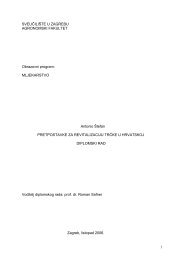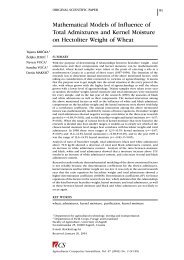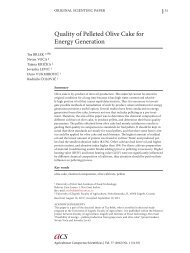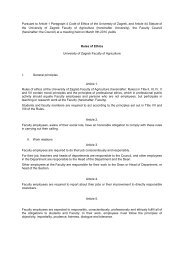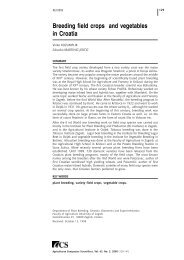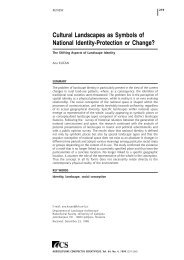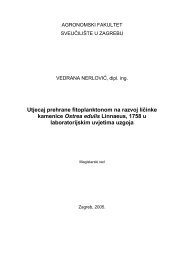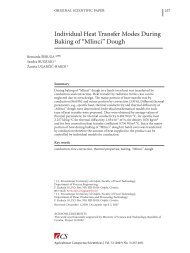Identification of Abiotic and Biotic Factors Causing Deterioration ...
Identification of Abiotic and Biotic Factors Causing Deterioration ...
Identification of Abiotic and Biotic Factors Causing Deterioration ...
You also want an ePaper? Increase the reach of your titles
YUMPU automatically turns print PDFs into web optimized ePapers that Google loves.
122 Basanta Kumar DASFigure 2.Microbial growth in NPSFigure 3.Microbial growth in NPSFigure 4.Microbial growth in UV & sundried flowersFigure 5.No microbialgrowth inantibiotics treatedflowersThe biotic factors causing spoilage were isolated <strong>and</strong> identifiedas Aspergillus flavus, Aspergillus niger, Rhizopus stolonifer <strong>and</strong>Penicillium citrinum. Besides, two Gram positive bacteria werecausing deterioration in NPS (Fig. 2, 3, 4, 5) (Table 1 & 2). Morefungal colonies were observed than bacterial colonies throughoutthe year <strong>of</strong> storage (Fig. 6). It is also marked that duringrainy season the deterioration rate was significant with highernumber <strong>of</strong> microbial colonies found responsible for loweringcarbohydrate content (Fig. 7 <strong>and</strong> 8).To check spoilage or deterioration, various storage techniquesi.e. physical <strong>and</strong> chemical treatments were experimented. It wasdetermined that solar radiation could not inhibit microbialgrowth (Fig. 4). The UV-irradiated flowers in the characteristicculture media showed no trace <strong>of</strong> microorganisms but incitingbiotic agents reappeared when the treatment was not carriedout at frequent intervals (Fig. 4). However, treatment <strong>of</strong> antibiotics<strong>and</strong> liquid nitrogen showed no trace <strong>of</strong> microorganisms inNPS (Fig. 5). Trace <strong>of</strong> the microbes could not be detected at anystage <strong>of</strong> the investigation using LPS in the culture media (Fig.1). It was further detected that inoculation <strong>of</strong> earlier preservedpure cultures <strong>of</strong> microbes into the culture media with antibioticsexhibited no microbial growth. Again, conversion to oxalicacid form was good in production <strong>and</strong> purity aspects (Tab. 3).DiscussionA conscious attempt has been made from the beginning <strong>of</strong> theinvestigation to maintain the original quality <strong>of</strong> the flowers. Oneset <strong>of</strong> samples was stored following traditional method (Jerkin,1982) <strong>and</strong> used it (NPS) as per the necessity <strong>and</strong> other set wasprocessed by an indigenously developed method <strong>of</strong> the labora-Table 1. Bacteria isolated from NPS flowersType <strong>of</strong> bacteria Color Form/margin Elevation/shape Growth RemarksGram positive Whitish yellow Shining, oval Flat, continuous Good, patches CoccusGram positive Brown Oily, irregular Flat, continuous Good, patches CoccusTable 2. Fungi isolated from NPS flowersType <strong>of</strong> fungus Color Texture Mycelium Growth Type <strong>of</strong> reproductive organAspergillus flavus white velvet septate well delicate conidiophoresAspergillus niger black smooth septate well delicate conidiophoresPenicillium citrinum greenish-blue leathery septate well developed long erect conidiophoresRhizopus stolonifer brownish velvet coenocytic well developed long erect sporangiophoresAgric. conspec. sci. Vol. 75 (2010) No. 3
<strong>Identification</strong> <strong>of</strong> <strong>Abiotic</strong> <strong>and</strong> <strong>Biotic</strong> <strong>Factors</strong> <strong>Causing</strong> <strong>Deterioration</strong> During Storage <strong>and</strong> Development <strong>of</strong> Storage Techniques forMahua (Madhuca indica Syn. Bassia latifolia) flowers123Table 3. Oxalic acid production from Mahua flowersAmount <strong>of</strong> Mahua flower Ratio <strong>of</strong> acid mixture to Mahua flowers Oxalic acid yield in gm (w/v) Purity <strong>of</strong> Oxalic acid (%)60 gms 8.0 32 99.560 gms 10.0 36 99.560 gms 6.0 30 98.060 gms 12.5 38 99.060 gms 7.5 32 99.5Figure 6. Number <strong>of</strong> bacterial <strong>and</strong> fungal colonies countedon culture Petri plates <strong>of</strong> NPS. Data are the mean <strong>of</strong> fivereplicates with ±S.E.Figure 8. Carbohydrate content at highest <strong>and</strong> lowesthumidity <strong>and</strong> temperature during storage <strong>of</strong> LPS <strong>and</strong> NPS. Dataare the mean <strong>of</strong> three replicates with ±S.E.Figure 7. Total carbohydrate content during storage <strong>of</strong> LPS<strong>and</strong> NPS. Data are the mean <strong>of</strong> three replicates with ±S.E.tory (LPS). Two types <strong>of</strong> parallel samples were made in order tocarry out the work uninterruptedly throughout the year <strong>of</strong> storage(Das et al., 2010). Accordingly, stored NPS were taken outintermittently <strong>and</strong> exposed to the bright sun light on concretefloors, as a traditional storage practice followed by its collectors.The flowers actually get dried by this method <strong>and</strong> thereby, easyspoilage is averted (Ol<strong>and</strong>iram <strong>and</strong> Iwv, 1993; Varghese et al.,2002; Lee <strong>and</strong> Resurreccion, 2006). In order to h<strong>and</strong>le such situation,LPS were stored at low temperature following Mohammedet al. (1996) <strong>and</strong> Concellon et al. (2007). Powdering with liquidnitrogen <strong>and</strong> low temperature storage hindered growth <strong>of</strong> microorganisms.Hence, there was no spoilage during storage (Daset al., 2010) (Fig. 1). However, NPS showed spoilage (Fig. 2 & 3).Just after harvesting season, this part <strong>of</strong> the world experiencesrainy season when environmental temperature get lowered to30-32 0 C with increased moisture content. This is the most favourablecondition for microbial growth <strong>and</strong> proliferation (Fig.6). In the most cases the microorganisms use the food as its nutrientssource for growth <strong>and</strong> proliferation. By increasing theirnumbers utilizing nutrients, producing enzymatic changes <strong>and</strong>contributing <strong>of</strong>f odor by breakdown <strong>of</strong> products or synthesis <strong>of</strong>new compounds, the invisible microbes cause spoilage, decay <strong>and</strong>deterioration <strong>of</strong> the nutrients (Mowlah <strong>and</strong> Itoo, 1983; Rodriguezet al., 1999). Again, the presence <strong>of</strong> rich carbohydrate contentmight have added to the process <strong>of</strong> spoilage <strong>and</strong> damage <strong>of</strong> theflowers more easily as studied earlier (S<strong>and</strong>erson <strong>and</strong> Spotts, 1995;Sholberg et al., 1996; Skinner <strong>and</strong> Banfield, 1997; Pace, 1999).Added, with the onset <strong>of</strong> rainy season the rate <strong>of</strong> carbohydratecontent deterioration was higher as environment became moresuitable for microbial growth <strong>and</strong> proliferation.The microbes isolated <strong>and</strong> studied according to their color,mycelium, texture, growth, reproductive organ etc. <strong>and</strong> the fungi(Fig. 2; Fig. 6) grew luxuriantly by utilizing the nutrients, producingvarious enzymatic changes <strong>and</strong> contributing <strong>of</strong> flavourby breaking down forming products (Chaitanya et al., 2000a;Errampalli et al., 2006). Specially, microbes used ascorbic acid,a potential <strong>and</strong> effective scavenger <strong>of</strong> free radicals for its owndefence system under high moisture content. Besides, two Grampositive bacteria, which resemble yeasts have been identifiedhere, might be causing fermentation <strong>of</strong> the flowers (Table 1).Agric. conspec. sci. Vol. 75 (2010) No. 3
124 Basanta Kumar DASSince the flowering occurs only once in a year, the development<strong>of</strong> proper storage techniques felt necessary. Physical treatmenti.e. sun drying is an old <strong>and</strong> traditional practice <strong>of</strong> storage.In the present investigation, the practice could not inhibit thegrowth (Fig. 4) <strong>of</strong> microbes as the drying could not reduce theavailable moisture content to a great extent, in NPS. Anotherphysical treatment i.e. UV-irradiation, is most widely used infood industries (Doyle, 2000; Mariam et Al., 2009). Radiationnear wavelength 260 nm is absorbed strongly by purines <strong>and</strong>pyrimidines, thereby it is mostly germicidal (Luther, 1999). Inpresent investigation UV-ray treatment completely inactivatedthe microbes when treated but later on, microbes reappeared ontreated flowers (NPS). This has happened because <strong>of</strong> ubiquity <strong>of</strong>microbes <strong>and</strong> reactivation <strong>of</strong> established microbes with certainmodifications in their characters (Fig. 4). These attributes <strong>of</strong>the microbes during storage have been marked by a number <strong>of</strong>workers (Aidoo, 1993; Zagory, 1999; Lopez et al., 2007; Mariamet Al., 2009).The use <strong>of</strong> antibiotics is a well-established practice to protectstored grains against microbial spoilage <strong>and</strong> damage (Eckert<strong>and</strong> Ogawa, 1988; Ligia et Al., 2008). It showed positive resultsby inhibiting bacterial <strong>and</strong> fungal cell wall development, theirenzymatic activity <strong>and</strong> action mechanism (Debano <strong>and</strong> Gordee,1994; Arthur, 1996; Errampalli et al., 2006). However, the optimizationdosages <strong>of</strong> antibiotics are cumbersome <strong>and</strong> timeconsumingaffairs (Levy, 1998). Again, the economic aspect <strong>and</strong>adverse impact <strong>of</strong> antibiotics usage on human beings are to beproperly assessed before their application.In the 2 nd chemical treatment i.e. liquid nitrogen treatmentwas the most effective <strong>and</strong> a completely new step towards foodstorage in less storage space. It completely dried the flowers <strong>and</strong>their preservation inside the deep freezer did not allow microbialgrowth (Table 1) due to very low temperature <strong>and</strong> moisture freeenvironment (Yaman <strong>and</strong> Bayindirh, 2002; Ismael <strong>and</strong> Pedro,2009). Although a number <strong>of</strong> workers have stored in modifiedenvironment (Mohammed et al., 1996; Kappel et al., 2002; Ligiaet. al, 2008) but this type <strong>of</strong> specialized storage condition-modifiedatmospheric packaging (MAP) with treatment is new one<strong>and</strong> did not show spoilage (Das et al., 2010).The 3 rd type was Nitric acid (HNO 3 ) treatment that resultedin oxalic acid formation (Table 3). It is used as a dye <strong>and</strong> drugintermediates in the application <strong>of</strong> dye stuffs to textiles, metalcleaning <strong>and</strong> treatment, permanent press, wrinkle resistance fabrics,plastics, photography, food industries etc (Hosttettmann etal., 1998). In India, major raw material for Oxalic acid is sugarcane,in view <strong>of</strong> the occurrence <strong>of</strong> more sugar in Mahua flowersit constitutes an alternate potential to oxalic acid production.Again, oxalic acid is largely used as a preservative <strong>and</strong> no losswas marked during its storage. It also requires less space forstorage <strong>and</strong> when necessary it can be sold without any loss inmarket value.ConclusionLiquid nitrogen treatment was the most effective <strong>and</strong> a newstep for storage <strong>of</strong> Mahua flowers. Next to it is the oxalic acidform <strong>of</strong> the flowers that has beneficial effects for varied uses.These findings are unique proper storage <strong>of</strong> such carbohydraterich flowers on large scale <strong>and</strong> it would definitely strengthen thefinancial status <strong>of</strong> its collectors. Attention should also be divertedfor manufacturing <strong>of</strong> more alcoholic beverages from Mahuaflowers due to presence <strong>of</strong> high amount <strong>of</strong> sugar content. Theretention <strong>of</strong> the quality <strong>of</strong> the flowers during postharvest storagethus should be the principal concern. The work done hereis a step in achieving that objective. Upon further assiduousanalysis, the information obtained <strong>and</strong> technologies developedwill no doubt act as the catalyst to solve hunger <strong>and</strong> malnutritionto a great extent.ReferencesAdhikary, S., Adhikary, J., 1989. Sal olein <strong>and</strong> Mahua olein fordirect edible use. J. Am. Oil Chem. Soc. 66(11), 1625-1630.Aidoo, K.E., 1993. Postharvest storage <strong>and</strong> preservation <strong>of</strong> tropicalcrops. Inter. Biodet <strong>and</strong> Biodegrade. 32, 161-173.Anonymous, 1995. Wealth <strong>of</strong> India. Raw material, Vol-VI, (L-M),CSIR, New Delhi, India. pp. 208-217.Arthur, F.H., 1996. Grain protectants. Current status <strong>and</strong> prospectsfor the future. J. Stored Prod. Res. 32, 293-302.Chaitanya, K.S.K., Keshavkant, S., Naithani, S.C., 2000a. Changesin total protein <strong>and</strong> protease activity in dehydrating recalcitrantsal (Shorea robusta) seeds. Silvafennica. 34, 71-77.Concellon, A., Anon, M.C., Chaves <strong>and</strong> A.R., 2007. Effect <strong>of</strong>low temperature storage on physical <strong>and</strong> physiologicalcharacteristics <strong>of</strong> eggplant fruit (Solanum melongena L.) LWT -Food Science <strong>and</strong> Technology, 40(3), 389-396Das, B. K., Choudhury, B. K, <strong>and</strong> Kar, M., 2010. Quantitativeestimation <strong>of</strong> changes in biochemical constituents <strong>of</strong> Mahua(Madhuca indica Syn. Bassia latifolia) flowers duringpostharvest Storage. J. <strong>of</strong> Food Processing <strong>and</strong> Preservation.Available online, DOI 10.1111/j.1745-4549.2009.00398.x.Debano, M. <strong>and</strong> Gordee, R.S., 1994. Antibiotics that inhibit fungalcell wall development. Annual Rev. Microbiol. 48, 471-497.Doyle, M.P., 2000. Reducing food borne disease. Food Technol. 54(11), 130.Eckert, J.W. <strong>and</strong> Ogawa, E.P., 1988. The chemical control <strong>of</strong>postharvest diseases, deciduous fruits, berries, vegetables, <strong>and</strong>root tuber crops. Ann. Rev. Phytopathol. 26, 433-469.Errampalli, D., Brubacher, M.R. <strong>and</strong> Deeio, J.R., 2006. Sensitivity <strong>of</strong>Penicillium expansum to diphenylamine <strong>and</strong> thiobendazole <strong>and</strong>post-harvest control <strong>of</strong> blue mold with fludioxonil in Mclntoshapples. Postharvest Biol. <strong>and</strong> Tech. 39, 101-107.Hostettmann, K., Potterat, O. <strong>and</strong> Wolfender, J., 1998. The potential<strong>of</strong> higher plants as a source <strong>of</strong> new drugs. Chmia. 52, 10-17.International Seed Testing Association (ISTA), 1985. Determination<strong>of</strong> moisture content. Seed Sci. <strong>and</strong> Technol. 13, 338-341.Ismael Sánchez-Ramos <strong>and</strong> Pedro Castañera, 2009. Chemical <strong>and</strong>physical methods for the control <strong>of</strong> the mite Acarus farris onCabrales cheese. Journal <strong>of</strong> Stored Products Research, 45 (1),61-66.Jerkin, P.D., 1982. Losses in sweet potatoes stored under traditionalconditions in Bangladesh, Trop. Sci. 24,17-28.Kappel, F., Toivonen, P., Mckenzie, D.L. <strong>and</strong> Stan, S., 2002. Storagecharacteristics <strong>of</strong> new sweet cherry cultivars. Hort. Sci. 37,139-143.Lee, C.M., Resurreccion <strong>and</strong> A.V.A., 2006. Consumer acceptance <strong>of</strong>roasted peanuts affected by storage temperature <strong>and</strong> humidityconditions, LWT - Food Science <strong>and</strong> Technology, 39( 8),872-882.Levy, S.B., 1998. Challenges <strong>of</strong> antibiotic resistance. Sci. Am. 278(3), 46-53.Agric. conspec. sci. Vol. 75 (2010) No. 3
<strong>Identification</strong> <strong>of</strong> <strong>Abiotic</strong> <strong>and</strong> <strong>Biotic</strong> <strong>Factors</strong> <strong>Causing</strong> <strong>Deterioration</strong> During Storage <strong>and</strong> Development <strong>of</strong> Storage Techniques forMahua (Madhuca indica Syn. Bassia latifolia) flowers125Ligia V. Antonia da Silva, Witoon Prinyawiwatkul, Joan M. King,Hong Kyoon No, Joseph, D. Bankston Jr. <strong>and</strong> Beilei Ge , 2008.Effect <strong>of</strong> preservatives on microbial safety <strong>and</strong> quality <strong>of</strong>smoked blue catfish (Ictalurus furcatus) steaks during roomtemperaturestorage. Food Microbiology, 25 (8), 958-963.Lopez, M.L., Villatoro, C., Fuentes, T., Graell, J., Lara, I. <strong>and</strong>Echeverria, G., 2007. Volatile compounds , quality parameters<strong>and</strong> consumer acceptance <strong>of</strong> “Pink Lady”® apples stored indifferent conditions. Postharvest Biol. <strong>and</strong> Tech. 43, 55-66.Lutter, R., 1999. Food irradiation, the neglected solution to foodborne illness. Sci. 286, 2275-2276.Mariam Begum, Ailsa D. Hocking <strong>and</strong> Di Miskelly, 2009.Inactivation <strong>of</strong> food spoilage fungi by ultra violet (UVC)irradiation. International Journal <strong>of</strong> Food Microbiology, 129 (1),74-77.Mohamed, S., Taufik, B. <strong>and</strong> Karim, M.N.A., 1996. Effects <strong>of</strong>modified atmospheric packaging on the physiochemicalcharacteristics <strong>of</strong> chiku (Archras sapota L) at various storagetemperatures. J. <strong>of</strong> Sci. Food Agric. 70, 231-240.Mowlah, G. <strong>and</strong> Itoo, S., 1983. Changes in pectic components,ascorbic acid, pectic enzymes <strong>and</strong> cellulase activity in ripening<strong>and</strong> stored guava (Psidium guava L.). J. Japanese Soc. Food Sci.Technol. 30, 454-461.Ol<strong>and</strong>iram, A.O. <strong>and</strong> IWV, L.N., 1993. Studies on the fungiassociated with tomato fruit rots <strong>and</strong> effect <strong>of</strong> environment instorage. Mycopathology. 121, 157-161.Pace, N.R., 1999. Microbial ecology <strong>and</strong> diversity. ASM News. 65,238-333.Rodriguez, R., Jimnenez, A., Guillen, R., Heredia, A. <strong>and</strong>Fern<strong>and</strong>ez-Bolanos, J., 1999. Turnover <strong>of</strong> white asparagus cellwall polysaccharides during postharvest storage. J. <strong>of</strong> Agric.Food. Chem. 47, 4528-4531.S<strong>and</strong>erson, P.G. <strong>and</strong> Spotts, R.A., 1995. Postharvest decay <strong>of</strong>winter pear <strong>and</strong> apple fruit caused by species <strong>of</strong> Penicillium.Phytopathol. 85, 103-110.Sholberg, P.L. <strong>and</strong> Haag, P.D., 1996. Incidence <strong>of</strong> postharvestpathogens <strong>of</strong> stored apples in British Columbia. Can. J. Pl.Pathol. 18, 81-85.Singh, P.<strong>and</strong> Agrawal, O.N., 1989. Detoxification <strong>of</strong> Mahua (Bassialatifolia) seed cake by alcohol treatment. Biol. Wastes. 29,229-231.Skinner, H.C.W. <strong>and</strong> Banfield, J.F.,1997. Microbes all around.Geotimes. 42 (8), 16-19.Sujatha, C.H. <strong>and</strong> Das, P.K., 1988. Evaluation <strong>of</strong> plant extracts forbiological activity against mosquitoes. Int. Pest. Control. 30 (5),122-124.Varghese, B., Naithani, R., Dulloo, M.E. <strong>and</strong> Naithani, S.C., 2002.Seed storage behaviour in Madhuca indica J.F. Gmel. Seed Sci.<strong>and</strong> Technol. 30, 107-47.Yaman, O. <strong>and</strong> Bayindirh, L., 2002. Effect <strong>of</strong> an edible coating <strong>and</strong>cold storage on shelf life <strong>and</strong> quality <strong>of</strong> cherries. Lebensn.–wiss.u. –Technol. 35,146-150.Zagory, D., 1999. Effect <strong>of</strong> post processing, h<strong>and</strong>ling <strong>and</strong> packagingon microbial populations. Postharvest Biol. <strong>and</strong> Technol. 15,313-321.acs75_17Agric. conspec. sci. Vol. 75 (2010) No. 3





